| Article ID | Journal | Published Year | Pages | File Type |
|---|---|---|---|---|
| 4696704 | Marine and Petroleum Geology | 2009 | 19 Pages |
A variety of shallow gas indicators and fluid migration pathways have been interpreted from new sub-bottom profiler, multibeam bathymetry, side-scan sonar, and echo-sounder data together with geochemical analyses of sampled sediments from the northern Arafura Sea, offshore Northern Australia. This study provides new geological data and a seismic stratigraphy of the youngest units in the Money Shoal Basin, in an area that has not been closely studied in over 30 years. The shallow gas indicators include pockmarks, low frequency enhanced reflectors and acoustic blanking. These indicators are supported by gas within shallow cores. Geochemistry indicates that this gas has a microbial origin but deeper fluid movement is also suggested by the presence of interpreted hydrocarbon slicks based on synthetic aperture radar data. A region of likely hydrocarbon seepage is indicated by the clear coincidence of shallow gas indicators with an area of increased faulting and a zone of poor quality seismic data (recognised on conventional seismic data), together with anomalies (interpreted on remote-sensing data) aligned with mapped deep structures.
